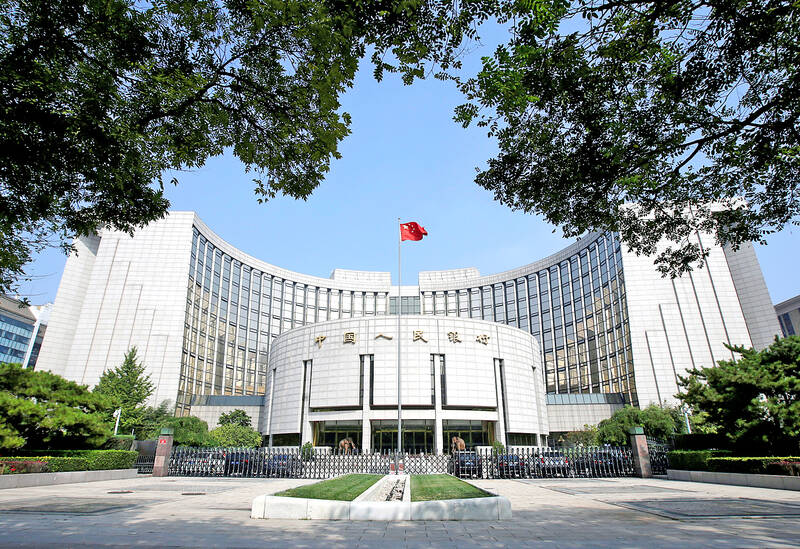China’s central bank lowered the interest rate charged on its one-year policy loans by the most on record, kicking off a sweeping program to revive confidence in the world’s second-largest economy.
The People’s Bank of China (PBOC) cut the rate of the medium-term lending facility (MLF) to 2 percent from 2.3 percent, according to a statement yesterday. The 30-basis-point cut was the biggest since the bank began using the monetary tool to guide market interest rates in 2016.
The expected move followed PBOC Governor Pan Gongsheng’s (潘功勝) announcement the previous day of a broad stimulus package that amounted to an adrenaline shot for an economy on the cusp of a deflationary spiral.

Photo: Reuters
“The cut is part of the package,” said Bruce Pang (龐溟), chief economist for Greater China at Jones Lang LaSalle Inc.
“The market is keeping a close eye on the strength, frequency and synergy of measures to follow as China strives to achieve this year’s around 5 percent growth goal,” Pang said.
The cut to the MLF rate is a prelude to more significant measures, such as a promised reduction in the rate on seven-day reverse repurchase notes, which the PBOC increasingly favors as the main policy lever.
The rate on those instruments would be lowered by 20 basis points to 1.5 percent “soon,” Pan said on Tuesday.
“Looking ahead, we see room for the PBOC to do more on the rates front than Pan has signaled so far. There’s a chance the central bank could trim the seven-day reverse repo rate by a further 10 [basis points] on top of the move Pan flagged on Tuesday,” Bloomberg economist David Qu (曲天石) said.
Reflecting the new framework, the monetary authority withdrew a net 291 billion yuan (US$41.4 billion) via the MLF, the biggest drainage since December 2021.
The outstanding MLF loans are widely expected to be gradually replaced by other tools, including cash injections through reserve requirement ratio (RRR) cuts, as the PBOC seeks to influence market borrowing costs more effectively.
“The MLF may be downgraded to become a tool to adjust the marginal borrowing costs of banks,” said Xing Zhaopeng (邢兆鵬), senior strategist at Australia & New Zealand Banking Group. “The MLF rate in the future could change following movements in market rates.”
The central bank chief revealed a plan to unleash 1 trillion yuan in long-term liquidity with a 50 basis-point reduction of the RRR, which determines the amount of cash lenders must keep in reserve. Along with other new funding tools, the measures more than compensated for the effect of the net withdrawal on market liquidity.
“Looking ahead, there is room for further replacement of MLF liquidity with RRR cut-induced liquidity given heavy MLF maturity in the coming months,” said Frances Cheung, (張淑嫻) a strategist at Oversea-Chinese Banking Corp.
The rate cut on the one-year lending yesterday “renders the facility more aligned with the funding costs” in the interbank market, she added.

Intel Corp chief executive officer Lip-Bu Tan (陳立武) is expected to meet with Taiwanese suppliers next month in conjunction with the opening of the Computex Taipei trade show, supply chain sources said on Monday. The visit, the first for Tan to Taiwan since assuming his new post last month, would be aimed at enhancing Intel’s ties with suppliers in Taiwan as he attempts to help turn around the struggling US chipmaker, the sources said. Tan is to hold a banquet to celebrate Intel’s 40-year presence in Taiwan before Computex opens on May 20 and invite dozens of Taiwanese suppliers to exchange views

Application-specific integrated circuit designer Faraday Technology Corp (智原) yesterday said that although revenue this quarter would decline 30 percent from last quarter, it retained its full-year forecast of revenue growth of 100 percent. The company attributed the quarterly drop to a slowdown in customers’ production of chips using Faraday’s advanced packaging technology. The company is still confident about its revenue growth this year, given its strong “design-win” — or the projects it won to help customers design their chips, Faraday president Steve Wang (王國雍) told an online earnings conference. “The design-win this year is better than we expected. We believe we will win

Chizuko Kimura has become the first female sushi chef in the world to win a Michelin star, fulfilling a promise she made to her dying husband to continue his legacy. The 54-year-old Japanese chef regained the Michelin star her late husband, Shunei Kimura, won three years ago for their Sushi Shunei restaurant in Paris. For Shunei Kimura, the star was a dream come true. However, the joy was short-lived. He died from cancer just three months later in June 2022. He was 65. The following year, the restaurant in the heart of Montmartre lost its star rating. Chizuko Kimura insisted that the new star is still down

While China’s leaders use their economic and political might to fight US President Donald Trump’s trade war “to the end,” its army of social media soldiers are embarking on a more humorous campaign online. Trump’s tariff blitz has seen Washington and Beijing impose eye-watering duties on imports from the other, fanning a standoff between the economic superpowers that has sparked global recession fears and sent markets into a tailspin. Trump says his policy is a response to years of being “ripped off” by other countries and aims to bring manufacturing to the US, forcing companies to employ US workers. However, China’s online warriors